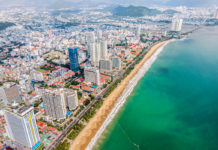Vietnam is a country known for its stunning landscapes, rich culture, and delicious cuisine. But did you know that it also offers some of the best diving destinations in the world? With over 3,000 kilometers of coastline and numerous islands, Vietnam is a paradise for divers looking to explore the underwater world. From vibrant coral reefs to historic shipwrecks, there is something for every type of diver in Vietnam. In this article, we will take a closer look at the top diving destinations in Vietnam and everything you need to know before planning your next diving trip.
Who Should Dive in Vietnam?
Diving in Vietnam is suitable for all levels of divers, from beginners to advanced. The country offers a diverse range of dive sites, making it ideal for both recreational and technical diving. Whether you are a novice diver looking to get certified or an experienced diver seeking new challenges, Vietnam has something for everyone.
Best Time to Dive in Vietnam
The diving season in Vietnam runs from February to October, with the peak season being from April to August. During this time, the weather is warm and dry, and the water visibility is at its best. However, if you prefer fewer crowds and lower prices, you can also visit during the off-peak season from November to January.
What to Expect Underwater
Vietnam’s underwater world is home to an incredible variety of marine life, including colorful corals, tropical fish, and even larger creatures like sharks and rays. You can also expect to see unique critters such as nudibranchs, seahorses, and frogfish. The water temperature ranges from 24-30°C (75-86°F), so you can comfortably dive in a wetsuit or a rash guard.
Top Diving destinations in Vietnam
Vietnam is a country known for its beautiful coastline and diverse marine life. Here are some of the top diving destinations in Vietnam:
1. Nha Trang: Located on the south-central coast, Nha Trang offers crystal clear waters and a variety of dive sites suitable for all levels of divers. Hon Mun Marine Protected Area is particularly popular due to its vibrant coral reefs and abundant marine species.
2. Phu Quoc: Situated in the Gulf of Thailand, Phu Quoc Island is surrounded by turquoise waters and teeming with marine life. There are several diving spots around the island, including An Thoi Archipelago and Turtle Island, where you can explore stunning coral gardens and encounter colorful fish.
3. Con Dao: Con Dao Island is an archipelago off the southern coast of Vietnam, known for its pristine beaches and untouched underwater ecosystem. Hon Ba and Hon Tai are popular dive sites here, offering opportunities to spot turtles, rays, and even dugongs.
4. Cham Islands: Located near Hoi An, the Cham Islands are a UNESCO Biosphere Reserve renowned for their biodiversity. This marine sanctuary boasts vibrant coral reefs and various dive sites suitable for both beginners and experienced divers.
5. Whale Island: Situated in Nha Trang Bay, Whale Island (Hon Ong) is a secluded diving destination famous for its relaxed atmosphere and diverse marine life. Explore the surrounding reefs and discover a wide array of tropical fish, sea turtles, and even whale sharks during their migrating season.
Make sure to contact local dive operators or centers for the most up-to-date information on diving conditions and to book your dives. Happy exploring!
How to Dive in Vietnam
Now that you know who should dive in Vietnam, let’s take a look at how you can make the most out of your diving experience in this beautiful country.
Getting There
The main international airports in Vietnam are located in Hanoi and Ho Chi Minh City. From there, you can take a domestic flight to popular diving destinations such as Nha Trang, Phu Quoc, or Con Dao. You can also travel by bus or train, but these options may take longer and be less convenient.
Choosing a Dive Center
There are numerous dive centers scattered throughout Vietnam, so it’s essential to do your research before booking with one. Look for a reputable dive center that has experienced instructors, well-maintained equipment, and good safety standards. You can also check online reviews and ask for recommendations from fellow divers.
Dive Sites and Itineraries
Vietnam offers a wide range of dive sites, each with its unique features and marine life. Some popular dive sites include Hon Mun Marine Protected Area in Nha Trang, Whale Island in Van Phong Bay, and Con Dao National Park. Most dive centers offer day trips to nearby dive sites, as well as liveaboard trips to more remote locations.
Pros and Cons of Diving in Vietnam
As with any destination, there are both pros and cons to consider when planning a diving trip to Vietnam. Let’s take a closer look at some of them.
Pros:
- Affordable: Compared to other popular diving destinations, Vietnam offers relatively affordable diving packages, making it an attractive option for budget travelers.
- Diversity of Dive Sites: With over 2,000 islands and a long coastline, Vietnam offers a diverse range of dive sites suitable for all levels of divers.
- Cultural Experience: Diving in Vietnam not only allows you to explore the underwater world but also gives you the opportunity to immerse yourself in the local culture and cuisine.
Cons:
- Weather Conditions: The weather in Vietnam can be unpredictable, and strong winds and rough seas can affect diving conditions.
- Limited Visibility: While the water visibility is generally good, it can be affected by weather conditions and plankton blooms, reducing visibility at times.
- Crowds: Some popular dive sites in Vietnam can get crowded during peak season, which may affect your overall diving experience.
Alternatives to Diving in Vietnam
If you are looking for alternative diving destinations in Southeast Asia, here are some options to consider:
- Thailand: With its crystal-clear waters and diverse marine life, Thailand is a popular diving destination for beginners and experienced divers alike.
- Indonesia: With over 17,000 islands, Indonesia offers endless diving opportunities, from vibrant coral reefs to thrilling drift dives.
- Philippines: The Philippines boasts some of the most biodiverse waters in the world, with over 7,000 islands to explore and an abundance of marine life.
Step-by-Step Guide to Diving in Vietnam
Now that you have all the necessary information, here is a step-by-step guide to help you plan your diving trip to Vietnam:
- Research and choose a reputable dive center.
- Book your flights and accommodation.
- Check the visa requirements for your country and apply if necessary.
- Pack appropriate dive gear and clothing for the weather.
- Arrive at your chosen dive destination and check-in with your dive center.
- Complete any necessary paperwork and attend a briefing before your first dive.
- Enjoy your dives and explore the underwater wonders of Vietnam!
- After your trip, don’t forget to leave a review and share your experience with others.
Tips for Diving in Vietnam
To make the most out of your diving experience in Vietnam, here are some tips to keep in mind:
- Bring sunscreen and insect repellent: The sun can be intense, especially on liveaboard trips, so make sure to protect your skin. Mosquitoes can also be a nuisance, so bring insect repellent.
- Respect the marine life: As with any diving destination, it’s essential to respect the marine life and their habitats. Do not touch or disturb any creatures, and avoid damaging corals.
- Stay hydrated: The weather in Vietnam can be hot and humid, so make sure to drink plenty of water to stay hydrated.
- Be mindful of your surroundings: Keep an eye out for boats and other divers while diving, and always follow the instructions of your dive guide.
- Learn some basic Vietnamese phrases: While English is widely spoken in tourist areas, learning a few basic phrases in Vietnamese can help you communicate with locals and enhance your cultural experience.
FAQs
What is the cost of diving in Vietnam?
The cost of diving in Vietnam varies depending on the dive center, location, and type of dive. On average, a single dive can cost between $30-$50 USD, while a day trip can range from $80-$120 USD. Liveaboard trips can cost anywhere from $500-$1000 USD per person.
Is it safe to dive in Vietnam?
Yes, it is generally safe to dive in Vietnam as long as you follow the safety guidelines and listen to your dive guide. Make sure to choose a reputable dive center and check the weather conditions before diving.
Can I rent diving equipment in Vietnam?
Yes, most dive centers in Vietnam offer rental equipment, but it’s always best to bring your own if possible. Make sure to check the condition of the equipment before diving.
What is the water temperature in Vietnam?
The water temperature in Vietnam ranges from 24-30°C (75-86°F) throughout the year.
Do I need a visa to visit Vietnam?
It depends on your nationality. Some countries are exempt from visas for short stays, while others require a visa Vietnam. Make sure to check the visa requirements for your country before traveling.
Conclusion
Vietnam is a hidden gem when it comes to diving destinations, offering a unique blend of culture and underwater wonders. With its diverse range of dive sites, affordable prices, and warm hospitality, it’s no wonder that more and more divers are flocking to this beautiful country. So pack your bags, grab your dive gear, and get ready to explore the underwater wonders of Vietnam!
























